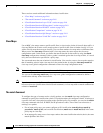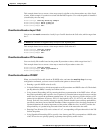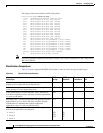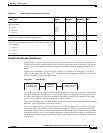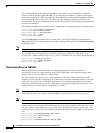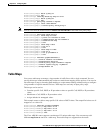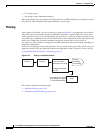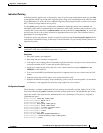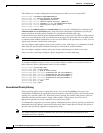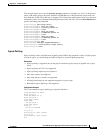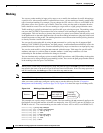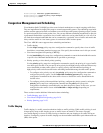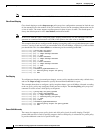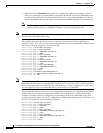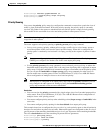
24-16
Cisco ASR 901 Series Aggregation Services Router Software Configuration Guide
OL-23826-09
Chapter 24 Configuring QoS
Understanding QoS
The following is a sample configuration of policing ingress traffic over cross connect EVC.
Router(config)# interface GigabitEthernet0/3
Router(config-if)# service instance 22 ethernet
Router(config-if-svr)# encapsulation dot1q 22
Router(config-if-svr)# rewrite ingress tag pop 1 symmetric
Router(config-if-svr)# xconnect 1.1.1.1 100 encapsulation mpls
Router(config-if-svr)# service-policy input policy1
Router(config-if-svr)# exit
You can use the conform-action and exceed-action policy-map class configuration commands or the
conform-action and exceed-action policy-map class police configuration commands to specify the
action to be taken when the packet conforms to or exceeds the specified traffic rate.
Conform actions are to send the packet without modifications, to set a new CoS, DSCP, or IP precedence
value, or to set a QoS group value for classification at the egress. Exceed actions are to drop the packet,
to send the packet without modification, to set a new CoS, DSCP, or IP precedence to a value, or to set
a QoS group value for classification at the egress.
You can configure each marking action by using explicit values, table maps, or a combination of both.
Table maps list specific traffic attributes and map (or convert) them to other attributes.
You can configure multiple conform and exceed actions simultaneously for each service class.
After you create a table map, configure a policy-map policer to use the table map.
Note In Cisco ASR 901, the from–type action in the table map must be cos.
To configure multiple actions in a class, you can enter multiple conform or exceed action entries in
policy-map class police configuration mode, as in this example:
Router(config)# policy-map map1
Router(config-pmap)# class class1
Router(config-pmap-c)# police 100000 500000
Router(config-pmap-c-police)# conform-action set-cos-transmit 4
Router(config-pmap-c-police)# conform-action set-qos-transmit 4
Router(config-pmap-c-police)# exceed-action set-cos-transmit 2
Router(config-pmap-c-police)# exceed-action set-qos-transmit 2
Router(config-pmap-c-police)# exit
Router(config-pmap-c)# exit
Router(config-pmap)# exit
Unconditional Priority Policing
Priority policing applies only to output policy maps. You can use the priority policy-map class
configuration command in an output policy map to designate a low-latency path, or class-based priority
queuing, for a specific traffic class. With strict priority queuing, the packets in the priority queue are
scheduled and sent until the queue is empty, at the expense of other queues. Excessive use of
high-priority queuing can create congestion for lower priority traffic.
To eliminate this congestion, you can use priority with implicit policer (priority policing) to reduce the
bandwidth used by the priority queue and allocate traffic rates on other queues. Priority with police is
the only form of policing supported in output policy maps.
Note You cannot configure a policer committed burst size for an unconditional priority policer. Any
configured burst size is ignored.



